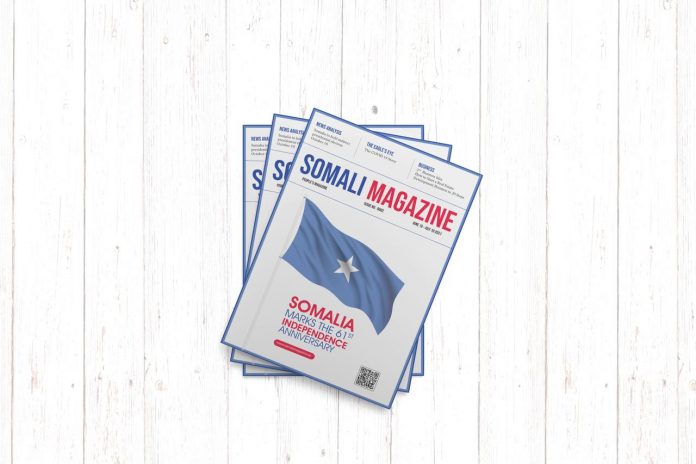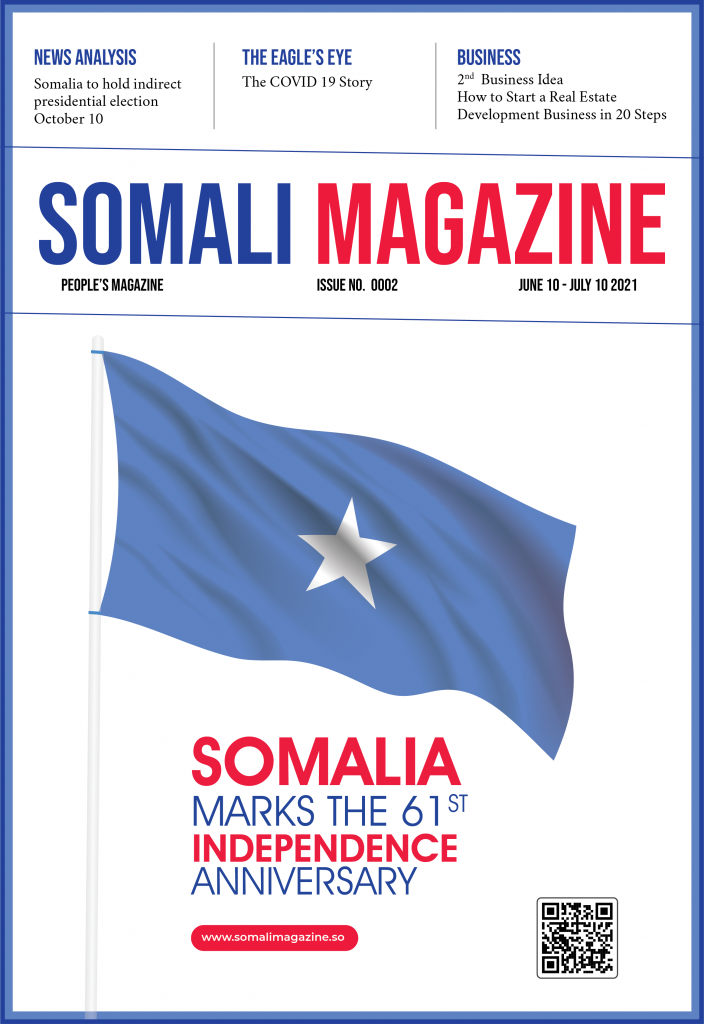
The ceremony usually marks the date that Somalia’s northern regions under British colonial control and the southern regions under Italian control merged to form the Somali Republic then led by Aden Abdulle.
Political leaders and diplomats gathered at Villa Somalia, the official residence of the President, as the national sky-blue flag was hoisted again mimicking the events on the midnight of July 1, 1960.
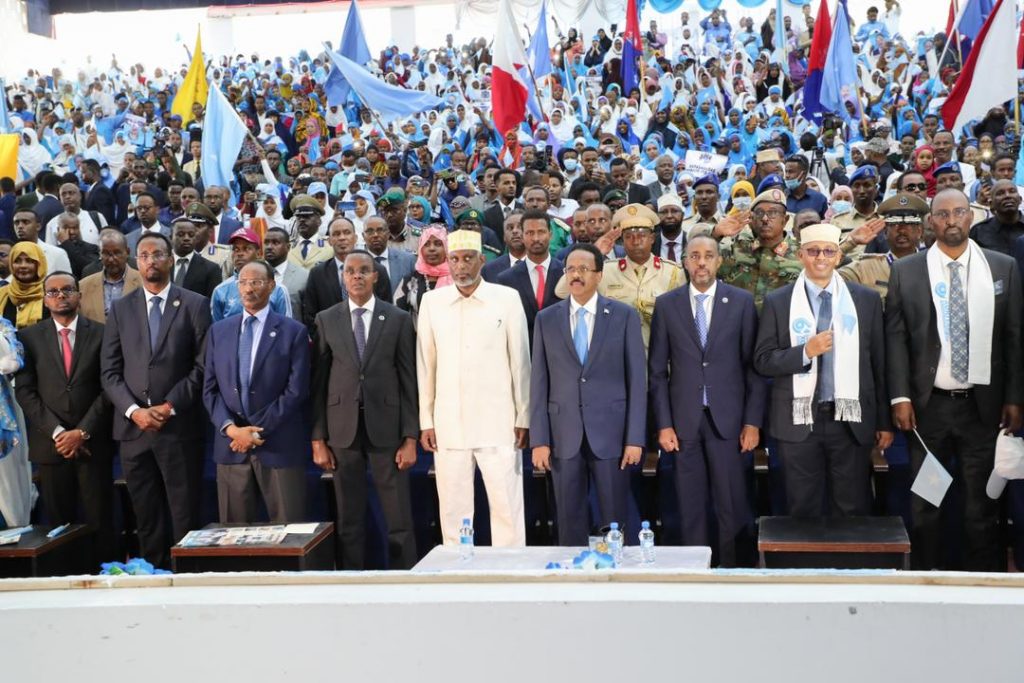
A guard of honor saluted President Farmaajo as the national hymn was played. Somalia’s President Mohamed Abdullahi Mohamed Farmaajo called for national unity as the country marked 61 years of independence on Thursday.
Farmaajo, facing an election in three months, used the occasion to rally the country for national unity, saying defending independence and freedom as envisioned by the country’s forefathers is the harder part.
“I urge my fellow Somalis to solemnly acknowledge and commemorate the efforts of our forefathers, but also to preserve our independence and unity,” he told the gathering, significantly reduced due to Covid-19 restrictions.
On Wednesday evening, Prime Minister Mohamed Hussein Roble, the man charged with organising the upcoming indirect elections, sent his wishes on “the glorious day” for Somalia, saying the celebrations mark the unity of its people.
Roble and regional leaders united under the National Consultative Forum (NCF) on June 29 signed a new agreement indicating a timeline for the envisaged elections, including the presidential election set for October 10.
But Somalia’s unity has routinely come under question.
The northern region of Somaliland has since 1991 declared independence although no country recognizes it.
On the eve of July 1, hundreds of youth paraded along the main avenues, draped in attire decorated with the Somali flag.

Most of the youngsters converged at Daljirka Daahsoon (the Unknown Soldier) monument in downtown Mogadishu. The youth were later joined by the Mayor of Mogadishu Omar Mohamed Filish. The international community also congratulated Somalia on its independence anniversary.
“On this day, sixty-one years ago, the people of Somalia realized their independent sovereign nation and committed themselves to build a peaceful and prosperous nation based on unity, equality, and justice,” said James Swan, UN’s special envoy to Somalia.
His Highness the Amir Sheikh Tamim bin Hamad al-Thani and His Highness the Deputy Amir Sheikh Abdullah bin Hamad al-Thani sent Thursday cables of congratulations to Somalia President Mohamed Abdullahi Farmaajo, on his country’s Independence Day. HE the Prime Minister and Minister of Interior Sheikh Khalid bin Khalifa bin Abdulaziz al-Thani sent a similar cable of congratulations to Prime Minister Mohamed Hussein Roble.
Turkey, Qatar, and African Union’s peacekeeping mission in the East African country also issued congratulatory messages.
Historical Back Ground
In the late 19th century, during the so-called Scramble for Africa when the European powers wrestled with each other for control of the continent, the British and Italians established the colonies of British Somaliland and Italian Somaliland.
Early History
Brief background on nation
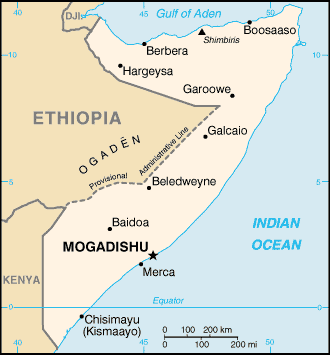
Early History
The original settlers of the Somali region were ethnic Cushites from the fertile lakes of southern Ethiopia. This group is subdivided into a number of other ethnicities, which are still readily recognized (and fought over) today. Archeological evidence supports the idea that most of the coastline of present-day Somalia had been settled by AD 100. G.W.B. Huntingford has argued in his translation of the Periplus of the Erythraean Sea, written about this time, that the “Lesser and Greater Bluffs”, the “Lesser and Greater Strands”, and the “Seven Courses” of Azania all should be identified with the Somali coastline from Hafun south to Siyu Channel. This indicates that parts of Somalia were familiar to Roman and Indian traders by this time.
These early villages put the Somalis in contact with Arab traders travelling along the Red Sea and Indian Ocean. In the ensuing centuries, the Somalis were one of the first peoples to convert to Islam. The Arabs established the city of Zeila (Now Saylac) on the Horn of Africa which would last as a central trading hub until the 17th century, when it was sacked by Christian Ethiopians.
In the Middle Ages the formation of the clan-family political structure began to take shape, when extended families of persecuted Muslims elsewhere in Arabia, fled en masse to the frontier in Somalia. Their relative affluence made them powerful, and inter-marriage with the locals produced economically beneficial relationships. During the 1300s, the future capital city of Mogadishu came to prominence as a favorite “party town” for Arab sailors.
Muslim Somalia enjoyed friendly relations with neighboring Christian Ethiopia for centuries. Despite jihad raging everywhere else in the Arab world, Somalia promised never to attack Ethiopia. The fact that Ethiopia has some of the most forbidding natural terrain in the world didn’t hurt the peace effort. Unfortunately, in 1414 an aggressive Ethiopian king, Yeshaq I, came to the throne and launched a war against Somalia and Djibouti. His campaign was successful, and the Somali king was executed. King Yeshaq had his minstrels compose a song praising his victory, which contains the first written record of the word “Somali”.
The Somalis lived under Ethiopian domination for a century or so. However, starting around 1530 under the charismatic leadership of Imam Ahmed Gragn (Gurey or left-handed in Somali), they retaliated. Regrouped Muslim armies marched into Ethiopia employing scorched earth tactics and slaughtering every Ethiopian they could get their hands on. The complete annihilation of Ethiopia was averted by the timely arrival of a Portuguese expedition led by Pedro da Gama, son of the famed navigator Vasco da Gama. The Portuguese needed help with their activities in the Indian Ocean so they formed an alliance with their fellow Christians, and a joint Portuguese-Ethiopian force defeated the Muslim army on February 21, 1543 at the Battle of Wayna Daga, and Ahmed Gragn was killed in battle.
Ahmed Gragn’s widow married Nur ibn Mujahid in return for his promise to avenge Ahmed’s death, who succeeded Ahmed Gragn, and continued hostilities against his northern adversaries until his death in 1567; the Ethiopians sacked Zeila in 1660. The Portuguese, meanwhile, established a major economic colony in Somalia, primarily engaged in textile manufacturing.
In the 17th century, Somalia fell under the sway of the rapidly expanding Ottoman Turks, who exercised control through handpicked local Somali governors. In 1728 the Ottomans evicted the last Portuguese colony and claimed sovereignty over the whole Horn of Africa. However, their actual exercise of control was fairly modest, as they demanded only a token annual tribute and appointed a Turkish judge to act as a kind of Supreme Court for interpretations of Islamic law. In all other respects, the local governors ignored the Ottomans. By the 1850s Turkish power was in decline, and the annual tribute was being paid more out of force of habit, than from fear of possible retribution.
Colonial Era
Starting in 1875 the age of Imperialism in Europe transformed Somalia. Britain, France, and Italy all made a territorial claims on the peninsula. Britain already controlled the port city of Aden in Yemen, just across the Red Sea, and wanted to control its counterpart, Berbera, on the Somali side. The Red Sea was seen as a crucial shipping lane to British colonies in India, and they wanted to secure these “gatekeeper” ports at all costs.
The French were interested in coal deposits further inland and wanted to disrupt British ambitions to construct a north-south transcontinental railroad along Africa’s east coast, by blocking an important section.
Italy had just recently been reunited and was an inexperienced colonialist. They were happy to grab up any African land they didn’t have to fight other Europeans for. They took control of the southern part of Somalia, which would become the largest European claim in the country, but the least strategically significant.
In 1884 Egypt, which had declared independence from the waning Ottoman Empire, had ambitions of restoring its ancient power, and set its sights on East Africa. However, the Sudanese resisted Egypt’s advance and the Mahdist revolution of 1885 ejected the Egyptians from Sudan and shattered Egypt’s hope of a neo-Egyptian empire. The few advance troops that had made it to Somalia had to be rescued by the British and escorted back to their own side of the fence.
Thereafter, the biggest threat to European colonial ambitions in Somalia came from Ethiopian Emperor Menelik II who had successfully avoided having his own country occupied, and was planning to invade Somalia again. By 1900 he had seized the Ogaden region in western Somalia, which was mostly desert and only good for meager livestock production. Even today, long after all the Europeans had given up on their relatively valuable colonial possessions, Ogaden, the most barren of Somali provinces, is still frequently fought over by the two bordering nations.
Somali resistance to their colonial masters, both familiar and foreign, began in 1899 under the leadership of religious scholar Mahammad Abdille Hasan. Their primary targets were their traditional enemies the Ethiopians, and the British who controlled the most lucrative ports and were squeezing tax money from farmers who had to use the ports to ship their livestock to customers in the Middle East and India. Hasan was a brilliant orator and poet with a very strong following of Islamic fundamentalist dervishes who waged a very bloody guerilla war. This war lasted over two decades until the British Royal Air Force, having honed their skills in WWI, led a devastating bombing campaign against dervish strongholds in 1920, under which Hasan was forced to flee, dying of pneumonia soon after. As seen before, Somali fighting spirit tended to dissipate once their charismatic leader was vanquished, a characteristic the Americans would try to exploit near the end of the century. The dervish struggle was one of the longest and bloodiest anti-Imperial resistance wars in sub-Saharan Africa, and cost the lives of nearly a third of northern Somalia’s population, as well as egregious casualties on the Ethiopian and British sides.
While the British were bogged down by Mohammed bin Abdullah (known to the British as ‘The Mad Mullah’), the French made little use of their Somalian holdings, content that as long as the British were stymied, their job was done. This attitude may have contributed to why they were more or less left alone by the revolutionaries. The Italians, though, were intent on larger projects and established an actual colony to which a significant number of Italian civilians migrated and invested in major agricultural development. By this time Mussolini was in power in Italy. He wanted to improve the world’s respect for Italy by the expert economic management of Italy’s new colonies, upstaging the British and their various embarrassing problems with the colony natives.
Due to the constant fighting, the British were afraid to invest in any expensive infrastructure projects that might easily be destroyed by guerillas. As a result, when the country was eventually reunited in the 1960s, the north, which had been under British control, lagged far behind the south in terms of economic development, and came to be dominated by the South. The bitterness from this state of affairs would be one of the sparks of the future civil war.
By 1935, the British were ready to cut their losses in Somalia. The pastoralists they fought on a daily basis were routinely labeled “anarchists”, which seems prophetic today, considering Somalia’s lack of any government for the past decade. The dervishes refused to accept any negotiations. Even after they had been soundly defeated in 1920, sporadic violence continued for the entire duration of British occupation. To make matters worse, Italy invaded and conquered Ethiopia, which the British had been using to help their effort to put down the Somali uprisings. Now with Ethiopia unavailable, the British were faced with the option of doing the dirty work themselves, or packing up and looking for friendlier territory.
By this time many thousand Italian immigrants were living in Romanesque villas on extensive plantations in the south. Conditions for natives were unusually prosperous under fascist Italian rule, and the southern Somalis never violently resisted. It had become obvious then that Italy had won the horn of Africa, and Britain left upon Mussolini’s insistence, with little protest.
Meanwhile, the French colonies had faded to obsolescence with Britain’s dwindling control, and they too were abandoned. The Italians then enjoyed sole dominance of the entire East African region including Ethiopia, Djibouti, Somalia, and parts of northern Kenya.
World War II
Italian hegemony of Somalia was short-lived, because, at the outset of WWII, Mussolini realized he would have to concentrate his resources primarily on the home front to survive the Allied onslaught. As a result, the British were able to totally reconquer Somalia by 1941. During the war years, Somalia was directly ruled by a British military administration, and martial law was in place, especially in the north where bitter memories of past bloodshed still lingered.
Unfortunately, these policies were as ill-advised as they were previously. The irregular bandits and militias of the Somali outback received a windfall in weaponry, thanks to the worldwide surge in arms production from the war. The Italian settlers and other anti-British elements made sure the rebels got as many guns as they needed to cause trouble. Despite a fresh Somali thorn in their side, the British protectorate lasted until 1949, and actually made some progress in economic development. The British established their capital in the northern city of Hargeisa, and wisely allowed local Muslim judges to try most cases, rather than impose alien British military justice on the populace.
The British allowed almost all the Italians to stay, except for a few obvious security risks, and regularly employed them as civil servants, and in the educated professions. The fact that 9 out of 10 of the Italians were loyal to Mussolini and probably actively spying on the Italian army’s behalf, was tolerated due to Somalia’s relative strategic irrelevance to the larger war effort. Indeed, considering they were technically citizens of an enemy power, the British lent considerable leeway to the Italian residents, even allowing them to form their own political parties in direct competiton with British authority.
After the war, the British gradually relaxed military control of Somalia, and attempted to introduce democracy, and numerous native Somalian political parties sprang into existence, the first being the Somali Youth League (SYL) in 1945. The Potsdam conference was unsure of what to do with Somalia, whether to allow Britain to continue its occupation, to return control to the Italians, who actually had a significant amount of people living there, or grant full independence. This question was hotly debated in the Somalian political scene for the next several years. Many wanted outright independence, especially the rural citizens in the west and north. Southerners enjoyed the economic prosperity brought by the Italians, and preferred their leadership. A smaller faction appreciated Britain’s honest attempt to maintain order the second time around and gave their respect.
In 1948 a commission led by representatives of the victorious Allied nations wanted to decide the Somalian question once and for all. They made one particular decision, granting Ogaden to Ethiopia, which would spark war decades later. After months of vaciliations and eventually turning the debate over to the United Nations, in 1949 it was decided that in recognition of its genuine economic improvements to the country, Italy would retain a nominal trusteeship of Somalia for the next 10 years, after which it would gain full independence. The SYL, Somalia’s first and most powerful party, strongly opposed this decision, preferring immediate independence, and would become a source of unrest in the coming years.
Despite the SYL’s misgivings the 1950s were something of a golden age for Somalia. With UN aid money pouring in, and experienced Italian administrators who had come to see Somalia as their home, infrastructural and educational development bloomed. This decade passed relatively without incident and was marked by positive growth in virtually all parts of Somali life. As scheduled, in 1959, Somalia was granted independence, and power transferred smoothly from the Italian administrators to the by then well developed Somali political culture.
The SYL Legacy

The Somali Youth League (SYL) (Somali: Ururka Dhalinyarada Soomaaliyeed , Italian: Lega dei Giovani Somali or Lega Somala della Gioventù), initially known as the Somali Youth Club (SYC), was the first political party in Somalia. It played a key role in the nation’s road to independence during the 1940s, 1950s and 1960s.
At its foundation in 1943, the party had thirteen founding members. Three were Darod (the most important being Yasin Haji Osman Sharmarke(Osman Mahamud); three were Rahanweyn; two Reer Hamar; and five Hawiye. The Harari would become members in 1946 when SYL opened an office in Harar. SYL supported Greater Somalia with Harar being the capital and a combined Harari-Somali representatives were commissioned to reveal this proposal to the U.N office in Mogadishu. Somali Youth League members were significantly influenced by the earlier religious rebellion at the turn of the century of various religious figures such as Uways al-Barawi, Sheikh Hassan Barsane and Mohammed Abdullah Hassan. To empower the new party, the better educated police and civil servants were permitted to join it. By 1948, following an official visit to the territory by the Four Power Commission, the SYC was a well-structured political unit, Abdullahi Issa was elected as its Secretary General and renamed itself as the Somali Youth League (SYL) and began to open offices not only in Italian and British Somaliland, but also in the Ogaden and in the Northern Frontier District (NFD). The SYL’s stated objectives were to unify all Somali territories, including the NFD and the Ogaden; to create opportunities for universal modern education; to develop the Somali language by a standard national orthography; to safeguard Somali interests; and to oppose the restoration of Italian rule. SYL policy banned clannishness so that the thirteen founding members, although representing four of Somalia’s five major clans, refused to disclose their clan affiliations. Although the SYL enjoyed considerable popular support from northerners, the principal parties in British Somaliland were the Somali National League (SNL) and National United Front (NUF), mainly associated with the Isaaq clan, and the United Somali Party (USP), which had the support of the Dir (Gadabuursi) and Darod (Dulbahante and Warsangali) clans.
British Somaliland remained a protectorate of Britain until June 26, 1960, when it became independent. The former Italian Somaliland followed suit five days later. On July 1, 1960, the two territories united to form the Somali Republic, albeit within boundaries drawn up by Italy and Britain. A government was formed by Abdullahi Issa Mohamud and Muhammad Haji Ibrahim Egal with Aden Abdullah Osman Daar as the first President of the Somali Republic, and Abdirashid Ali Shermarke as Prime Minister, later to become President (from 1967-1969). On July 20, 1961 and through a popular referendum, the Somali people ratified a new constitution, which was first drafted in 1960.
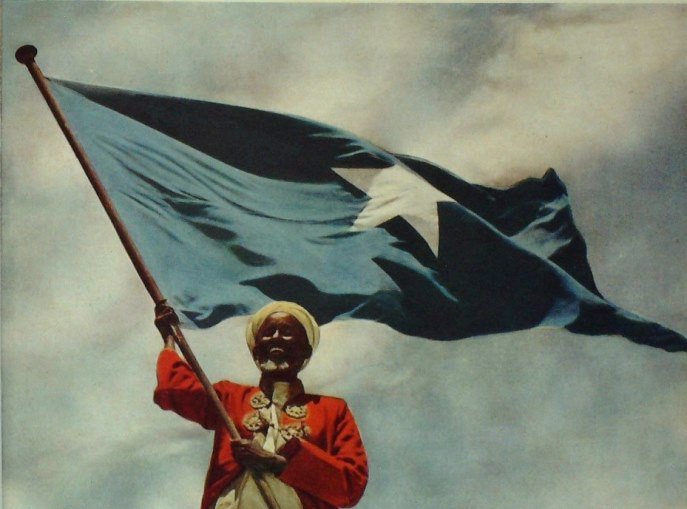
In the first national elections after independence, held on 30 March 1964, the SYL won an absolute majority of 69 of the 123 parliamentary seats. The remaining seats were divided among 11 parties. Five years from then, in general elections held in March 1969, the ruling SYL led by Mohammed Ibrahim Egal returned to power. However, in the same year, then President of Somalia Abdirashid Ali Sharmarke was assassinated. A military coup quickly ensued, with Siad Barre now assuming leadership. Barre’s Supreme Revolutionary Council (SRC) subsequently renamed the country the Somali Democratic Republic, arrested members of the former government, banned political parties, dissolved the parliament and the Supreme Court, and suspended the constitution.

